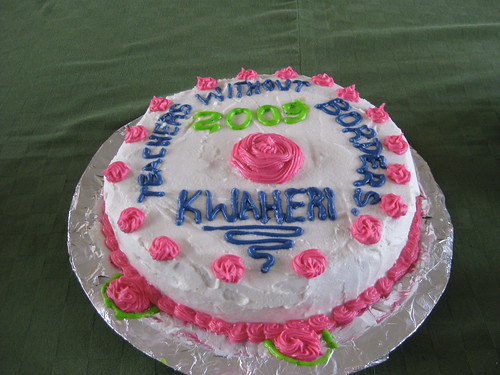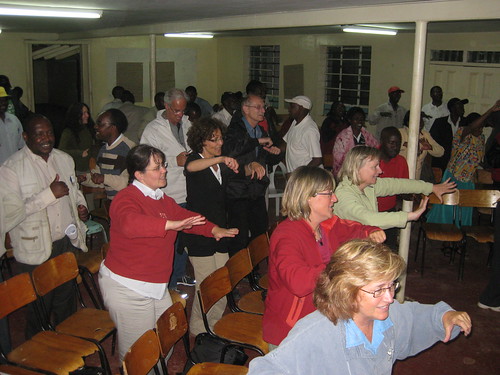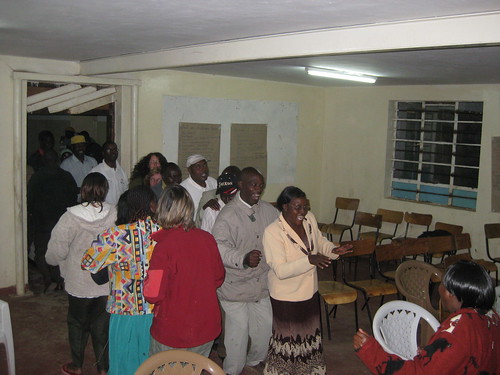8 August 09
I’ve had a bit of a self-imposed embargo on writing over the weekends here. I’ve figured the stray thoughts that pop up on Saturday and Sunday can work their way into Monday’s writings.
Today was just too good.
On our drive from Mbita to meet up with the other TWB-C team in Gilgil, we made a detour.
I don’t know if you’ve ever been to Kogelo, Kenya. I highly doubt it.
The team decided it would be fun. Well, that and everyone in Mbita said we should go. Well, that and it’s the location of Barak Obama’s paternal homestead.
We pulled up to the gate around an otherwise unassuming farming compound and the police stationed on the grounds asked us to sign in and present our passports.
We obliged.
A sort of cognitive dissonance existed in the fact that we were presenting our passports outside a house that could have been the neighbor to our home of the past week.
We walked up to the house and a guide of sorts showed us to where President Obama’s father and grandfather are buried. It was a little surreal.
“If you’d like to take a seat, Mama Sarah is finishing breakfast and will greet you shortly,” our guide said, gesturing to some chairs that had just been stationed under a grove of mango trees.
I thanked him.
“Shall we go?” Sharon asked a few moments later.
“Well, the guide said if we’d like to take a seat, we can meet Mama Sarah.”
“Who?”
“Mama Sarah. Obama’s grandmother.”
“Are you serious?”
“Yes.”
“Are you serious?”
“Yes.”
“Are you serious!”
“Yes. Please stop.”
We sat down.
Twenty minutes later, the door to the main house opened and a woman came out to let us know Mama Sarah would be coming out soon and to ask us to sign the book. (In Kenya, everywhere you visit has a book.)
Five minutes laster, Mama Sarah, a large, dark woman in the Kenyan equivalent of a housecoat appeared with her cane and sat facing our semicircle.
Some turkeys who had been entertaining/threatening us whilst we waited, let out a few gobbles.
The woman I took to be Mama Sarah’s aid made introductions and then asked us each to introduce ourselves.
We did.
She asked the assembled group if we had questions.
We sat noticeably silent.
Sharon looked at me, as I’ve proven to be the team’s go-to inquisitor. The thing was, I didn’t really have any questions. For all intents and purposes, we were sitting in an an elderly woman’s front yard after arriving unannounced.
Lois, who was sitting next to me, leaned in and said, “You have a smart question?”
I told her I was working on it.
Knowing President Obama has only been to Kenya twice in his life, it wasn’t as though I could pump this woman for information on baby Barack.
To make matters worse, the more aggressive of the two turkeys was taking what I interpreted to be an aggressive stance. I was trying to come up with an intelligent question while running the hypothetical of what kind of international incident might occur if I kicked the President’s grandmother’s turkey in the face and whether or not claiming self-defense would help.
Finally, I asked the only question that seemed to matter, “How has your life changed since the president’s election?”
Her aid translated my question and Mama Sarah responded in Kiswahili, saying she was seeing more visitors and was happy to greet them. Other than that, things were pretty much the same as pre-election.
John asked what advice she had for teachers.
“Teach them well, and teach them respect.”
I can dig that.
With no further pressing questions and the ability to say we’d been there, the team posed for a group shot around Mama Sarah and we loaded the van to leave.
As we rolled away, I was a bit relieved that Mama Sarah had been a normal Kenyan. I like the idea of our president coming from everyman stock.
A little wikipedia research later on revealed that Mama Sarah wasn’t President Obama’s biological grandmother. Rather, as polygamy is a fading practice in Kenya, she was his grandfather’s third wife. The president’s biological grandmother, his grandfather’s first wife, is now deceased. Still, as is the practice, children of polygamous unions refer to each of their fathers’ wives as their mothers.
 This has been living on the ‘
This has been living on the ‘ 15 August 09
15 August 09 14 August 09
14 August 09 There was singing, dancing, at least two conga lines, storytelling, more singing and, yes, some poetry.
There was singing, dancing, at least two conga lines, storytelling, more singing and, yes, some poetry.